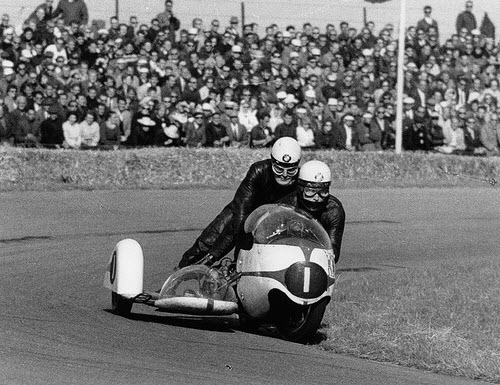


On July 16, 1930, Ing Zoller started building split-single two-stroke engines. It would be the engine that would make DKW a dominant racing motorcycle in the Lightweight and Junior classes between the wars.
The split-single system, or "Twingle", sends the intake fuel-air mixture up one bore to the combustion chamber, sweeping the exhaust gases down the other bore and out of the exposed exhaust port. The rationale of the split-single two-stroke is that, compared to a standard two-stroke single, it can give better exhaust scavenging while minimizing the loss of unburnt fresh fuel/air charge through the exhaust port. The belief is that a split-single engine can deliver better economy, and may run better at small throttle openings.
But there is a disadvantage to the split-single, for only marginal improvement over a standard two-stroke single, it is a heavier and costlier engine. That said, a manufacturer could produce a standard twin-cylinder two-stroke at an equivalent cost, so it was inevitable that the Twingle should become exTWinct.
Racing versions of this design were often mistaken for regular twin-cylinders, since they had two exhausts or two carburetors, but these are actually connected to a single bore in an engine with a single combustion chamber.
DKW had it's taste of fame and success with models such as the RT125, pre- and post-World War II. As reparations after the war, the design drawings of the RT125 were given to Harley-Davidson in the US and BSA in the UK. The Harley-Davidson version was known as the Hummer, while BSA used them for the Bantam.





Robbie Knievel challenges British world record holder and motorcycle stuntman extraordinaire Eddie Kidd to a world title 'jump off' competition in St. Louis, Missouri. Knievel had deemed Kidd to be the only jump rider in the world worthy of challenging him (hmm, bit of an ego?). The event was televised as a $19.95 pay per view event titled, "The Daredevil Duel, Knievel vs. Kidd". The competition required each rider to make three jumps, with the accumulative distance covered by each rider calculated to determine the winner of the contest. Kidd took the winner's belt by out-jumping Knievel by 6 feet. Robbie Knievel said he had hoped for a 'rematch', but three years later, Kidd retired after sustaining serious injuries in a motorcycle accident, so the opportunity for him to win the title belt back from Eddie was never to be realized. Heavy sigh, big pout.
Eddie Kidd worked as a stunt double in many films for actor's such as Timothy Dalton, Val Kilmer, Roger Moore, Michael Caine and Pierce Brosnan. One of his most famous stunts was in the 1979 film Hanover Street , doubling for Harrison Ford on a motorcycle, he jumped a 120 feet railway cutting at 90 miles per hour in Shepton Mallet, Somerset.







Evel Knievel, America's favorite daredevil strikes again.
In Centralia, Washington at the Lewis County Fairgrounds, Evel jumps 13 cars, eleven Dodge Coronets, one Dodge Monaco and a Dodge Polaris. From his Triumph T120 firing up on the first kick to the near perfect landing, the jump is a complete success. The Centralia jump marks seven successful attempts in a row dating back to June 19, 1966, in Missoula, Montana. Where attempting to jump twelve cars and a van, Evel's rear wheel catches the van's door frame resulting in a severely broken arm and several broken ribs.
Two and a half weeks later in Graham, Washington, at the Graham Speedway, the lucky streak comes to an abrupt halt in an attempt to jump sixteen VW Bugs and a panel delivery truck. If he had only stopped at the Bugs.





Bobby Hill is born in the small town of Triadelphia, West Virginia. Population 811.
After the frustration of consecutive second place finishes, on a sweltering, shirt-soaking Atlanta afternoon, on August 8, 1948, Bobby Hill finally wins his first race but, alas, he has to share it. In one of the most memorable races ever, Hill and Billy Huber crossed the line in a dead heat and both were declared winner, the only time that has happened in AMA racing history.
He would eventually win the AMA Grand National Championship in 1951 and 1952 by his victories on the Springfield Mile. By no means taking away from his feats but, from 1946 to 1953, the AMA Grand National Champion was crowned based solely on the results of the Springfield Mile held at the Illinois State Fairground racetrack.
After winning the national title in 1951 and 1952 riding an Indian, he won the Daytona 200 in 1954 while piloting a BSA.
Hill won a total of 12 AMA nationals during his professional racing career between the years 1947 to 1959.
Bobby Hill was inducted to the AMA Motorcycle Hall of Fame in 1998.



























